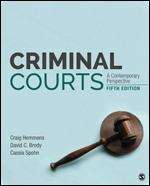Criminal Courts
A Contemporary Perspective
- Craig Hemmens - Washington State University, USA
- David C. Brody - Washington State University, USA
- Cassia Spohn - Arizona State University, USA
Comprehensive and engaging, Criminal Courts: A Contemporary Perspective explores all aspects of courts and related areas which are crucial to the criminal justice system. Written by three nationally recognized experts in the field, this text examines court structure, courtroom actors, trial and appeal process, and in addition, judicial decision making, specialized courts, and comparative court systems.
By presenting up-to-date key cases, data, and current controversial discussions such as the death penalty or legalization of cannabis, this fifth edition provides students with opportunities to view topics from the perspectives of the participants involved in the process and take a position on the issue that is raised.
Supplements
Online resources included with this text
The online resources for your text are available via the password-protected Instructor Resource Site, which offers access to all text-specific resources, including a test bank and editable, chapter-specific PowerPoint® slides.
For additional information, custom options, or to request a personalized walkthrough of these resources, please contact your sales representative.
Clear and evidence based. Written by experts in the field.



